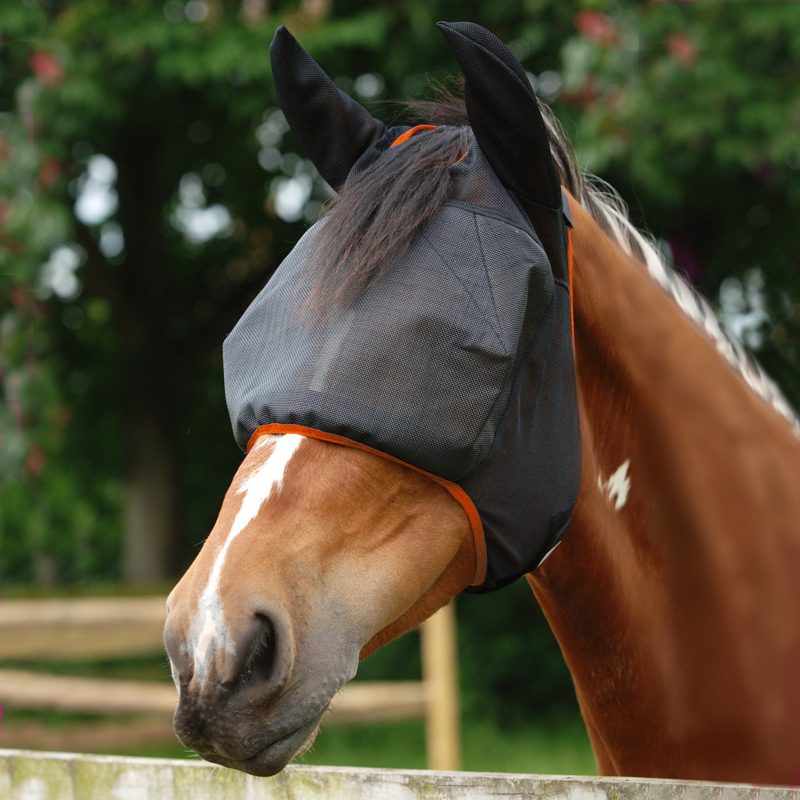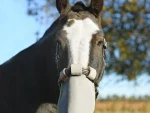1 year product guarantee
Free delivery on most orders over £40
Rated 4.9/5 stars on Feefo

Researched & tested products

Innovating for over 20 years!
Supporting Redwings Horse Sanctuary & Brooke
Feefo Gold Trusted Service Award Winner
Get more time to pay with Klarna
The Essential Guide to Choosing the Perfect Fly Mask for Your Horse
Choosing the Best Fly Mask for Your Horse
With different styles, colours and varying levels of protection now available, finding the perfect fly mask for your horse is no longer an easy task.
For many horse owners the confusion results in the purchase of a lesser quality fly mask, and often less effective mask that may mean compromising on protection, fit, or in some circumstances both.
Buying the cheapest fly mask in the shop can, in the long run, prove to be more costly as a less effective fit is likely to result in more losses and more damage in the field, thus reducing the lifespan of the fly mask and increasing the likely need to repurchase throughout the season.
So before you hit the tack shops for your summer essentials, be sure to keep reading for our top tips of what to consider before buying a fly mask…
What Style of Fly Mask Should I Choose?
Category
Horse Care & Equipment, Tack Matters, WellbeingFull Face Fly Mask
A full face fly mask is a great option if your horse is very sensitive to flies and midges, or if you need to protect your horse’s muzzle against the sun. For all-round protection, the Field Relief Max Fly Mask provides over 70% UV protection and is made from a durable mesh to keep flies at bay.
Fly Mask with Ears
Horses that are susceptible to irritation from midge bites often benefit from the additional protection a fly mask with ears can offer, but look carefully at the shape of the ears on the mask you are considering. Are they horse-ear shaped? Too often fly masks misjudge the actual shape of the horse’s ear, making them too straight or floppy and therefore easier for the horse to remove. Take a look at the Field Relief Midi with Ears and see how an ergonomic ear shape can make all the difference to the fit of your fly mask.
Fly Mask without Ears
Many horses find that a fly mask with ears to be an annoyance, which encourages them to rub and thus displace or pull their mask off completely. Many horses simply cannot tolerate anything touching their ears. Look for a fly mask with adjustable fastenings behind the ears so the fly mask doesn’t have to be put on over the head and ears.
For horses like this, a visor style like the Field Relief Midi is ideal for providing a high level of protection along with a secure fit.
Muzzle Fringe
Designed with a simple hook and loop attachment, the Field Relief® Muzzle Fringe attaches easily to all fly masks in the Field Relief® Range. Ideal for horses who might not like a traditional nose piece or cover, or need protection from the flies and midges without the UV protection.
Detachable Nose Piece
Designed with a simple hook and loop attachment, the Field Relief® Detachable Nose Piece attaches easily to all fly masks in the Field Relief® Range. Ideal for horses with pink or sensitive noses, who need UV protection, or those who are extremely sensitive to flies or midges around their muzzle.
What else is there to consider?
As a general rule, we would recommend for you to base the size of your fly mask on the size of your horse’s bridle. This is certainly the case for the Field Relief range of fly masks, but will also give you a good starting point for other brands.
Regardless of make, your fly mask should fit snugly (two fingers) around your horse’s face with no gaps over the poll or around the nose. Excessive space in these areas will make it easier for the fly mask to shift on your horse’s head, or pull off completely. To help with this, look for a fly mask with stretch seams and plenty of adjustability; the Field Relief range all feature stretch seams for a secure fit, with the Midi (with and without ears) also boasting hook and loop adjustment over the poll as well as under the cheeks for a more tailored fit.
Contrary to the snug fit needed elsewhere on your horse’s head, your fly mask should allow for plenty of room over the eye area. Vets agree that a mesh sitting directly against the eye has the potential to rub and cause damage to the eye and surrounding skin. Not only this but too tight a fitting mask may mean your horse’s eyelashes catch against the mesh, causing significant discomfort to your horse when blinking.
Be sure to choose a fly mask that provides some kind of structure over the eye area, and that you are confident it will not collapse down onto your horse’s face through the course of the day. For an example of what to look for, the Field Relief range of fly masks have all been designed with strategic darts over the front of the mask to ensure a stable, roomy fit with good clearance over the eyes.
A correctly fitting fly mask should not inhibit your horse’s natural movement or routine in any way. Your horse’s fly mask should stay in place, and not twist or shift on your horse’s head. This is where a secure fit is important, and where features like elasticated bindings or extra adjustability come in to play, as they allow the mask to move and adjust to the movement of your horse.
Horses with little or no skin pigmentation around their eyes and muzzle are going to be more susceptible to the effects of the sun. Like pale-skinned humans, exposure to the sun can cause squinting, watery eyes, sunburn, and in the long-term has the potential to develop in to cataracts or even cancer. A UV protective fly mask helps to block some of this damaging radiation from reaching the skin. In the short term, this helps to make your horse more comfortable, help to prevent sunburn, and could help to militate against more serious ailments in the future. The Field Relief range are tested to block out over 70% of harmful UV rays
There has been wide debate over recent years as to what the most suitable colour for a fly mask is, however there is no conclusive evidence to suggest that the colour makes any difference to the effectiveness of the fly mask. Many argue that a fly mask with a darker colour mesh is best as it provides a ‘sunglasses’ effect for photosensitive horses, but conversely it can be argued that as dark colours absorb heat a lighter coloured mask is best to reflect radiation instead. These may be points worth considering when purchasing a new fly mask, however there is no scientific evidence to support the significance of either theory.
If your horse is prone to getting hot during turnout, it is important to think carefully about the materials your chosen fly mask is made from. As a rule, the front of a fly mask is made from mesh to enable the horse to see clearly, however the weight of the material used for this can vary greatly. Too thick a mesh may be abrasive and likely to make your horse sweat, as air cannot freely circulate, but too fine a mesh is unlikely to maintain any structural stability whilst being worn.
It is also worth considering the linings and trimmings used on the inner seams. It has become more popular to have fleece linings to prevent rubbing. Sometimes these are made from real wool, which does possess thermo-regulating properties, but synthetic fleece is often used. Whilst this provides a good level of cushioning against the skin, it is not effective for controlling moisture, and if not cleaned regularly may have the opposite effect and cause rubbing rather than prevent it. Field Relief Fly Masks have soft, sponge cotton padding which prevents rubbing and stays cool.
Generally, a horse doesn’t need to wear a fly mask at night. If your horse has an eye condition and has been advised by a vet to wear a fly mask overnight, Field Relief fly masks can be left on 24/7. Note, whilst fly masks allow for clear visibility during the day, they may impair your horse’s night vision.
For horses out 24/7, we recommend making sure you check your horse regularly and allow him time without the mask to prevent the risk of rubbing.
The amount of time your horse should spend in a fly mask will vary depending on turnout routine, the type of mask you choose, and the weather. Most fly masks are designed to be worn for the best part of the day to provide protection, but they should be removed daily and washed regularly. Removing your horse’s fly mask gives you the opportunity to check your horse for rubs or skin irritations, and allows you to check the that the mask is still fitting correctly.
It is also advisable to have more than one fly mask for your horse, allowing one to be washed while the other is worn. Regular cleaning can reduce the chances of your horse developing bacterial infections should your mask rub. Do not leave your horse in a wet fly mask, it may increase the chances of rubbing or causing irritation.
While there are many owners who habitually replace their horses fly mask every year, this is not necessary if your existing fly mask is in a fit condition to be used.
Before using your fly mask again for the first time after winter, it is important to check it for any damage including rips, frays or damaged straps that may affect the fit of the fly mask. Frayed material or damage seams on the inside of the mask may also rub your horses face. If you see any damage to your fly mask it is always advisable to either repair or replace your fly mask.
Favourites Amongst Riders...
View all products-
 Field Relief Midi Fly Mask (no ears)£26.50 View product
Field Relief Midi Fly Mask (no ears)£26.50 View productField Relief Midi Fly Mask (no ears)
A horse fly mask without ears that ticks all the…
-
 Field Relief Fly Mask Max£34.50 View product
Field Relief Fly Mask Max£34.50 View productField Relief Fly Mask Max
Combining the best protection against summer irritants with exceptional comfort…
-
 Field Relief Midi Fly Mask With Ears£28.50 View product
Field Relief Midi Fly Mask With Ears£28.50 View productField Relief Midi Fly Mask With Ears
A horse fly mask with ears that ticks all the…
-
 Field Relief Muzzle Protector£14.50 View product
Field Relief Muzzle Protector£14.50 View productField Relief Muzzle Protector
Protect from sunburn with this simple nose protector offering over…
